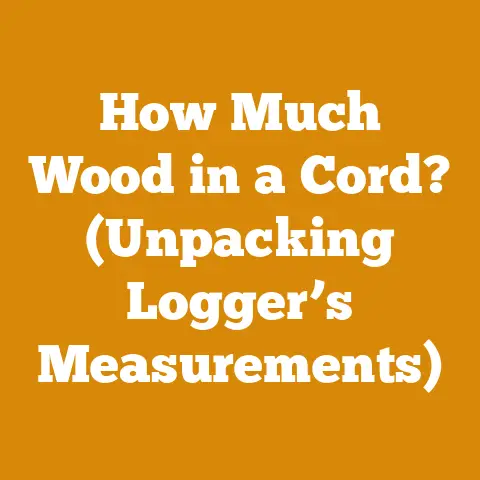How Far Can a 6×6 Beam Span for Pergola? (5 Load Tips)
Alright, folks, gather ’round the woodpile!
Ever wonder how far you can stretch a 6×6 beam without it sagging like a tired lumberjack after a day of felling trees?
Well, you’ve come to the right place.
I’m about to dive deep into the world of pergola spans, load calculations, and wood wisdom.
We’ll chop through the jargon, split the facts from the fiction, and stack up some solid advice.
So, grab your safety glasses (because knowledge can be dangerous!), and let’s get started!
What Determines the Span of a 6×6 Pergola Beam?
Several factors influence how far a 6×6 beam can safely span in your pergola.
These include:
- Wood Species: Different woods have different strengths.
Redwood, cedar, and pressure-treated pine are common choices, but their load-bearing capacities vary. - Grade of Lumber: The grade indicates the quality and strength of the wood.
A higher grade (like “Select Structural”) will support more weight over a longer span. - Load Requirements: This includes the weight of the pergola itself (dead load), plus any additional load from snow, wind, or hanging plants (live load).
- Beam Spacing: How far apart the beams are spaced affects the load distribution and the overall structural integrity.
- Local Building Codes: Always check your local building codes for specific requirements and restrictions.
Ignoring these is like trying to split a log with a butter knife – it just won’t work.
A Personal Anecdote: The Case of the Sagging Pergola
I once built a pergola for a friend who insisted on using reclaimed lumber.
It looked fantastic, all rustic and charming.
However, we didn’t properly assess the wood’s grade or load-bearing capacity.
The result?
A slight, but noticeable, sag in the main beam after the first heavy snowfall.
We had to reinforce it with additional supports.
Lesson learned: always know your wood!
5 Load Tips for Calculating Pergola Beam Spans
Here are five crucial tips to help you accurately calculate the span of your 6×6 pergola beam:
Tip 1: Identify Your Wood Species and Grade
Knowing your wood is paramount.
Think of it as knowing your chainsaw – each one has its strengths and limitations.
- Common Wood Species:
- Redwood: Naturally rot-resistant, relatively lightweight.
- Cedar: Similar to redwood, often used for its aesthetic appeal.
- Pressure-Treated Pine: Affordable and durable, but can be less visually appealing.
- Douglas Fir: Strong and readily available, a good all-around choice.
- Lumber Grades:
- Select Structural: Highest grade, fewest knots, strongest.
- No.
1: Fewer defects than lower grades, suitable for many applications. - No.
2: More knots and imperfections, weaker than No.
1. - No.
3: Lowest grade, not recommended for structural applications.
Actionable Metric: Always opt for “Select Structural” or “No.
1” grade lumber for pergola beams.
It’s an investment in the long-term stability of your structure.
Tip 2: Determine Your Dead Load
The dead load is the weight of the pergola itself.
This includes the beams, rafters, roofing material (if any), and any permanent fixtures.
- Estimating Dead Load:
- 6×6 Beam: Approximately 6-8 pounds per linear foot (depending on wood species).
- 2×6 Rafters: Approximately 2-3 pounds per linear foot.
- Roofing Material (e.g., lattice): Varies widely, consult manufacturer’s specifications.
Example Calculation: Let’s say you have a pergola with two 12-foot 6×6 redwood beams and 10 12-foot 2×6 rafters.
- Beam weight: 2 beams * 12 feet/beam * 7 lbs/foot = 168 lbs
- Rafter weight: 10 rafters * 12 feet/rafter * 2.5 lbs/foot = 300 lbs
- Total dead load (beams and rafters): 168 lbs + 300 lbs = 468 lbs
Actionable Metric: Keep a detailed record of the weight of each component.
Accurate estimates are crucial for accurate calculations.
Tip 3: Calculate Your Live Load
The live load is the weight of temporary or variable loads, such as snow, wind, rain, or hanging plants.
This is where things can get tricky, as these loads can vary significantly depending on your location.
- Snow Load: Consult your local building codes for snow load requirements.
These are typically expressed in pounds per square foot (psf). - Wind Load: Wind load also varies depending on your location and the pergola’s design.
Again, consult local building codes. - Hanging Plants: Estimate the weight of any hanging plants you plan to add.
A large potted plant can easily weigh 50-100 pounds.
Example Calculation: Let’s assume your local building code requires a snow load of 20 psf.
Your pergola is 12 feet wide and 12 feet long.
- Snow load: 20 psf * 12 feet * 12 feet = 2880 lbs
Actionable Metric: Always err on the side of caution when estimating live loads.
It’s better to overestimate than underestimate.
Tip 4: Use Online Span Calculators
Fortunately, you don’t have to be a structural engineer to determine the appropriate span for your 6×6 beam.
Several online span calculators can help you with this.
These calculators take into account the wood species, grade, load requirements, and other factors.
- Example Calculators:
- American Wood Council Span Calculator: A reliable tool based on engineering principles.
- Wood Beam Calculator (various websites): Search online for “wood beam span calculator” to find numerous options.
How to Use a Span Calculator:
- Input Wood Species: Select the type of wood you’re using (e.g., redwood, cedar, pressure-treated pine).
- Input Lumber Grade: Select the grade of lumber (e.g., Select Structural, No. 1).
- Input Beam Size: Enter the dimensions of your beam (6×6).
- Input Load Requirements: Enter the dead load and live load.
- View Results: The calculator will provide the maximum allowable span for your beam.
Actionable Metric: Use multiple span calculators and compare the results.
If there are significant discrepancies, investigate further.
Tip 5: Consult with a Structural Engineer or Experienced Builder
If you’re unsure about any aspect of the pergola design or load calculations, it’s always best to consult with a professional.
A structural engineer can provide a detailed analysis of your design and ensure that it meets all applicable building codes.
An experienced builder can offer practical advice and identify potential problems before they arise.
- Benefits of Consulting a Professional:
- Accurate Load Calculations: Professionals have the expertise to accurately calculate dead loads and live loads.
- Code Compliance: They can ensure that your pergola design meets all local building codes.
- Safety: A properly designed and built pergola is a safe pergola.
Actionable Metric: Obtain at least three quotes from different professionals before making a decision.
Estimating Span Distances: A Practical Guide
While online calculators are great, it’s helpful to have a general idea of what to expect.
Here’s a practical guide to estimating span distances for 6×6 pergola beams:
Rule of Thumb: Span Distances Based on Wood Species and Load
Keep in mind that these are general guidelines.
Always use a span calculator or consult with a professional for accurate calculations.
Example: If you’re using Select Structural redwood and your pergola is located in an area with moderate snow loads, you can expect a maximum span of around 8-10 feet.
If you’re using No.
1 pressure-treated pine, you should limit the span to 6-8 feet.
Understanding Load Distribution
The way the load is distributed across the beam also affects the allowable span.
- Uniformly Distributed Load: The load is evenly distributed across the entire length of the beam (e.g., snow load).
- Concentrated Load: The load is concentrated at a single point (e.g., a heavy hanging plant).
Rule of Thumb: Concentrated loads require shorter spans than uniformly distributed loads.
If you plan to hang heavy objects from your pergola, reduce the span accordingly.
The Importance of Beam Spacing
The spacing between the beams also plays a crucial role in the overall structural integrity of the pergola.
- Typical Beam Spacing: 2-4 feet.
- Effect of Spacing: Closer spacing allows for longer spans, as the load is distributed across more beams.
Example: If you’re using 6×6 redwood beams and spacing them 2 feet apart, you can likely achieve a longer span than if you were spacing them 4 feet apart.
Wood Selection: Choosing the Right Lumber for Your Pergola
Selecting the right wood is like choosing the right axe for the job – it makes all the difference.
Here’s a closer look at the common wood species used for pergolas:
Redwood: The Classic Choice
Redwood is prized for its natural beauty, rot resistance, and relatively light weight.
- Pros:
- Naturally rot-resistant.
- Beautiful reddish-brown color.
- Relatively lightweight.
- Cons:
- Can be expensive.
- Requires regular maintenance to prevent fading and weathering.
- Not as strong as some other wood species.
Best Use Cases: Pergolas in areas with moderate climates and a desire for natural beauty.
Cedar: Aromatic and Durable
Cedar is another popular choice for pergolas, known for its distinctive aroma and natural resistance to rot and insects.
- Pros:
- Naturally rot and insect-resistant.
- Pleasant aroma.
- Attractive grain patterns.
- Cons:
- Can be expensive.
- May require staining or sealing to maintain its color.
- Not as strong as some other wood species.
Best Use Cases: Pergolas in areas with moderate climates and a desire for a natural, aromatic wood.
Pressure-Treated Pine: Affordable and Long-Lasting
Pressure-treated pine is a budget-friendly option that offers excellent durability and resistance to rot and insects.
- Pros:
- Affordable.
- Highly resistant to rot and insects.
- Long-lasting.
- Cons:
- Can be less aesthetically pleasing than redwood or cedar.
- Requires special handling due to the chemicals used in the treatment process.
- May require staining or painting to improve its appearance.
Best Use Cases: Pergolas in areas with harsh climates or where budget is a primary concern.
Douglas Fir: Strong and Versatile
Douglas fir is a strong and readily available wood species that is suitable for a wide range of applications, including pergolas.
- Pros:
- Strong and durable.
- Readily available.
- Relatively affordable.
- Cons:
- Not as naturally rot-resistant as redwood or cedar.
- Requires regular maintenance to prevent rot and insect damage.
- Can be prone to warping or twisting if not properly dried.
Best Use Cases: Pergolas in areas with moderate climates and a need for a strong, versatile wood.
Timber Grading: Understanding the Quality of Your Lumber
Understanding timber grading is like knowing the sharpness of your axe – it tells you how well it will perform.
Here’s a breakdown of the common lumber grades:
Select Structural: The Top Choice
Select Structural is the highest grade of lumber, characterized by its strength, straightness, and minimal defects.
- Characteristics:
- Fewest knots and imperfections.
- Highest strength rating.
- Straight and true.
- Best Use Cases: Structural applications where strength and reliability are critical, such as pergola beams.
No. 1: A Good All-Around Option
No.
1 lumber is a good all-around choice for many applications, offering a balance of strength, affordability, and appearance.
- Characteristics:
- Fewer defects than lower grades.
- Suitable for most structural applications.
- May have some knots and imperfections.
- Best Use Cases: Pergola rafters, posts, and other structural components where strength is important but appearance is also a consideration.
No. 2: Economical but Weaker
No.
2 lumber is an economical option, but it has more knots and imperfections than higher grades, making it less strong.
- Characteristics:
- More knots and imperfections than No.
1. - Weaker than higher grades.
- Less expensive than higher grades.
- More knots and imperfections than No.
- Best Use Cases: Non-structural applications where appearance is not critical, such as fence boards or temporary bracing.
No. 3: Not Recommended for Structural Applications
No.
3 lumber is the lowest grade of lumber and is not recommended for structural applications.
- Characteristics:
- Many knots and imperfections.
- Weakest grade of lumber.
- Least expensive grade of lumber.
- Best Use Cases: Applications where strength and appearance are not important, such as firewood or mulch.
Pergola Design Considerations: Beyond the Beam Span
While the beam span is crucial, there are other design considerations to keep in mind when building a pergola.
Post Placement: Providing Solid Support
The placement of the posts is critical to the stability of the pergola.
- Typical Post Spacing: 8-12 feet.
- Effect of Spacing: Closer spacing provides more support and allows for longer beam spans.
Rule of Thumb: Place posts at the corners of the pergola and at regular intervals along the sides.
Rafter Design: Adding Shade and Style
The rafters are the horizontal members that run perpendicular to the beams, providing shade and adding to the pergola’s aesthetic appeal.
- Typical Rafter Spacing: 12-24 inches.
- Effect of Spacing: Closer spacing provides more shade and a more substantial look.
Design Tip: Consider using different rafter patterns to create a unique and visually appealing pergola.
Roofing Material: Adding Protection from the Elements
If you want to add protection from the sun or rain, you can add a roofing material to your pergola.
- Common Roofing Materials:
- Lattice: Provides partial shade and a decorative look.
- Shade Cloth: Provides shade and is relatively inexpensive.
- Polycarbonate Panels: Provide protection from the rain and sun.
- Solid Roofing: Provides complete protection from the elements.
Considerations: Choose a roofing material that complements the style of your pergola and provides the desired level of protection.
Tools and Equipment: What You’ll Need to Build Your Pergola
Building a pergola requires a variety of tools and equipment.
Here’s a list of the essentials:
Essential Tools
- Chainsaw: For cutting lumber to size (I prefer a Stihl MS 271 for its versatility).
- Circular Saw: For making accurate cuts.
- Drill/Driver: For drilling holes and driving screws.
- Level: For ensuring that the pergola is level and plumb.
- Tape Measure: For measuring lumber and distances.
- Square: For ensuring that corners are square.
- Hammer: For driving nails.
- Wrench Set: For tightening bolts.
- Safety Glasses: For protecting your eyes.
- Gloves: For protecting your hands.
Optional Tools
- Miter Saw: For making precise angle cuts.
- Planer: For smoothing rough lumber.
- Router: For creating decorative edges.
- Post Hole Digger: For digging post holes.
- Concrete Mixer: For mixing concrete.
Tool Tip: Invest in high-quality tools that will last for years.
It’s like sharpening your skills – the better the tool, the better the result.
Safety First: Protecting Yourself While Building
Safety should always be your top priority when building a pergola.
Here are some essential safety tips:
Wear Appropriate Safety Gear
- Safety Glasses: Protect your eyes from flying debris.
- Gloves: Protect your hands from splinters and cuts.
- Hearing Protection: Protect your ears from loud noises.
- Steel-Toed Boots: Protect your feet from falling objects.
Use Tools Safely
- Read the Manual: Before using any tool, read the manufacturer’s instructions carefully.
- Maintain Your Tools: Keep your tools clean and sharp.
- Use the Right Tool for the Job: Don’t try to force a tool to do something it’s not designed for.
- Be Aware of Your Surroundings: Keep your work area clean and free of obstacles.
Work with a Partner
- Two Heads Are Better Than One: Having a partner can help you with heavy lifting and provide a second set of eyes to watch for potential hazards.
- Communicate Clearly: Talk to your partner about the task at hand and any potential risks.
Take Breaks
- Avoid Fatigue: Working when you’re tired can increase the risk of accidents.
- Stay Hydrated: Drink plenty of water, especially on hot days.
Step-by-Step Pergola Construction: A Simplified Guide
Here’s a simplified step-by-step guide to building your pergola:
Step 1: Plan Your Pergola
- Determine the Size and Location: Decide how big you want your pergola to be and where you want to build it.
- Obtain Permits: Check with your local building department to see if you need a permit.
- Design Your Pergola: Create a detailed plan that includes the dimensions, materials, and construction methods.
Step 2: Gather Your Materials
- Purchase Lumber: Buy the lumber you need for the beams, posts, rafters, and other components.
- Purchase Hardware: Buy the screws, bolts, nails, and other hardware you’ll need.
- Purchase Concrete: Buy the concrete you’ll need for the post footings.
Step 3: Prepare the Site
- Clear the Area: Remove any vegetation, rocks, or other obstacles from the construction site.
- Mark the Post Locations: Use a tape measure and stakes to mark the locations of the posts.
- Dig the Post Holes: Dig holes for the posts, making sure they are deep enough to provide adequate support.
Step 4: Set the Posts
- Pour Concrete Footings: Pour concrete into the post holes to create a solid foundation.
- Set the Posts: Set the posts in the concrete, making sure they are level and plumb.
- Brace the Posts: Use temporary braces to hold the posts in place while the concrete cures.
Step 5: Install the Beams
- Cut the Beams to Length: Cut the beams to the correct length, using a chainsaw or circular saw.
- Attach the Beams to the Posts: Attach the beams to the posts, using screws or bolts.
- Make Sure the Beams Are Level: Use a level to ensure that the beams are level.
Step 6: Install the Rafters
- Cut the Rafters to Length: Cut the rafters to the correct length, using a chainsaw or circular saw.
- Attach the Rafters to the Beams: Attach the rafters to the beams, using screws or nails.
- Space the Rafters Evenly: Space the rafters evenly along the beams.
Step 7: Add Roofing Material (Optional)
- Install the Roofing Material: Attach the roofing material to the rafters, using screws or nails.
Step 8: Finish the Pergola
- Sand the Wood: Sand the wood to remove any rough edges.
- Stain or Paint the Wood: Stain or paint the wood to protect it from the elements and enhance its appearance.
Maintaining Your Pergola: Ensuring Long-Term Durability
Maintaining your pergola is like maintaining your chainsaw – regular care will keep it running smoothly for years to come.
Regular Inspections
- Check for Rot and Insect Damage: Inspect the wood regularly for signs of rot or insect damage.
- Check for Loose Connections: Check the screws, bolts, and nails to make sure they are tight.
- Check for Cracks and Warping: Inspect the wood for cracks and warping.
Cleaning
- Wash the Wood Regularly: Wash the wood with soap and water to remove dirt and debris.
- Use a Mildewcide: If you live in a humid climate, use a mildewcide to prevent mildew growth.
Staining or Sealing
- Reapply Stain or Sealer: Reapply stain or sealer every few years to protect the wood from the elements.
Trimming Vegetation
- Trim Overhanging Branches: Trim any overhanging branches that could damage the pergola.
- Remove Climbing Plants: Remove any climbing plants that could put excessive stress on the structure.
Case Studies: Real-World Pergola Projects
Let’s take a look at some real-world pergola projects and the lessons we can learn from them:
Case Study 1: The Redwood Pergola in California
- Project: A redwood pergola built in a backyard in California.
- Beam Span: 10 feet.
- Wood Species: Redwood, Select Structural.
- Load Requirements: Moderate snow load, occasional wind.
- Lessons Learned: Redwood is a beautiful and durable choice for pergolas in moderate climates.
Proper maintenance is essential to prevent fading and weathering.
Case Study 2: The Pressure-Treated Pine Pergola in Florida
- Project: A pressure-treated pine pergola built in a backyard in Florida.
- Beam Span: 7 feet.
- Wood Species: Pressure-treated pine, No. 1.
- Load Requirements: High humidity, occasional storms.
- Lessons Learned: Pressure-treated pine is a cost-effective and durable choice for pergolas in humid climates.
Regular inspections are essential to check for rot and insect damage.
Case Study 3: The Douglas Fir Pergola in Colorado
- Project: A Douglas fir pergola built in a backyard in Colorado.
- Beam Span: 9 feet.
- Wood Species: Douglas fir, Select Structural.
- Load Requirements: High snow load, strong winds.
- Lessons Learned: Douglas fir is a strong and versatile choice for pergolas in areas with high snow loads and strong winds.
Proper drying is essential to prevent warping and twisting.
Common Mistakes to Avoid: Learning from Others’ Errors
Building a pergola is a rewarding experience, but it’s also easy to make mistakes.
Here are some common mistakes to avoid:
Underestimating the Load
- Mistake: Failing to accurately calculate the dead load and live load.
- Consequence: The pergola may sag or collapse under heavy loads.
- Solution: Use a span calculator or consult with a structural engineer to accurately calculate the load requirements.
Using Low-Quality Lumber
- Mistake: Using low-grade lumber that is not strong enough to support the load.
- Consequence: The pergola may sag or collapse.
- Solution: Use Select Structural or No. 1 grade lumber for structural components.
Improper Post Placement
- Mistake: Placing the posts too far apart or not setting them deep enough.
- Consequence: The pergola may be unstable and prone to tipping over.
- Solution: Space the posts according to the design specifications and set them deep enough to provide adequate support.
Neglecting Maintenance
- Mistake: Failing to regularly inspect and maintain the pergola.
- Consequence: The pergola may deteriorate over time and require expensive repairs.
- Solution: Regularly inspect the pergola for rot, insect damage, and loose connections.
Clean the wood and reapply stain or sealer as needed.
Troubleshooting Pergola Problems: Addressing Common Issues
Even with careful planning and construction, problems can arise with your pergola.
Here are some common problems and how to address them:
Sagging Beams
- Problem: The beams are sagging under the weight of the load.
- Possible Causes:
- Underestimated load.
- Low-quality lumber.
- Excessive beam span.
- Solutions:
- Add additional supports to the beams.
- Replace the beams with stronger lumber.
- Reduce the beam span.
Rot and Insect Damage
- Problem: The wood is rotting or being damaged by insects.
- Possible Causes:
- Exposure to moisture.
- Lack of maintenance.
- Untreated lumber.
- Solutions:
- Remove the damaged wood and replace it with treated lumber.
- Apply a wood preservative to protect the remaining wood.
- Improve drainage to prevent moisture buildup.
Loose Connections
- Problem: The screws, bolts, or nails are loose.
- Possible Causes:
- Vibration.
- Expansion and contraction of the wood.
- Improper installation.
- Solutions:
- Tighten the loose connections.
- Replace the screws, bolts, or nails with larger ones.
- Use a locking adhesive to secure the connections.
Advanced Pergola Design: Taking Your Project to the Next Level
Once you’ve mastered the basics of pergola construction, you can start experimenting with more advanced designs.
Curved Beams
- Technique: Laminating thin strips of wood together to create a curved beam.
- Benefits: Adds a unique and elegant look to the pergola.
- Considerations: Requires specialized tools and techniques.
Cantilevered Beams
- Technique: Extending the beams beyond the posts to create an overhang.
- Benefits: Provides additional shade and a dramatic look.
- Considerations: Requires careful load calculations to ensure stability.
Integrated Lighting
- Technique: Incorporating lighting into the pergola design.
- Benefits: Adds ambiance and extends the usability of the pergola into the evening.
- Considerations: Requires careful planning and wiring.
Water Features
- Technique: Integrating water features, such as fountains or waterfalls, into the pergola design.
- Benefits: Adds a relaxing and visually appealing element to the pergola.
- Considerations: Requires careful planning and plumbing.
The Future of Pergola Design: Trends and Innovations
The world of pergola design is constantly evolving, with new trends and innovations emerging all the time.






